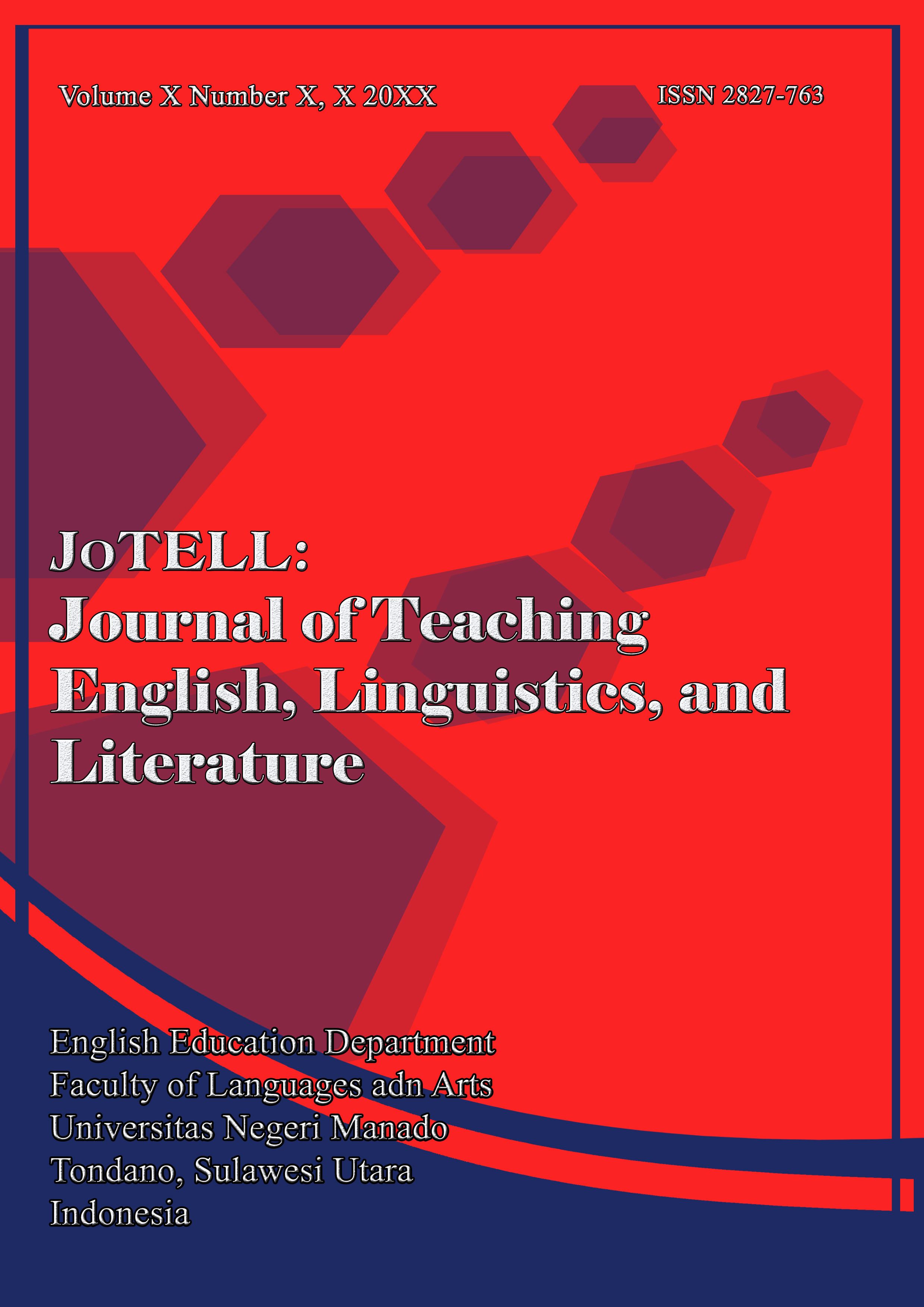An Analysis Of Students’ Ability In Writing Descriptive Text
DOI:
https://doi.org/10.36582/jotell.v3i12.9677Keywords:
Writing, analysis, descriptive, textAbstract
English as a foreign language is important language that must be learned for students to communicate with teachers, friends or even another person from a various country. the researcher is interested to focusing the research in analyzing the student ability and difficulties in writing especially in descriptive text. In this research, the researcher used Qualitative methods in analyzing student writing for descriptive texts involve collecting and analyzing non-numerical data to understand how students write and describe objects, places, or people. the subject matter in writing descriptive language were rated as good. The students' mean score for topic of sentence was 80,1 or good. Although they did not do an excellent job, the pupils did not do a terrible job of elaborating the offered topic. They were unsure of how to write and communicate their views. The students' mean score in sentence description was 70,4, which is considered ordinary. The students ability in develop of paragraph still lack, it become students had less of vocabularies. And the students' mean score in conclusion of sentence was 61,3 also classified as average. The students not know to summarizes main ideas every paragraph. And the students mean score was 70.6 which was classified as good
References
Arikunto, S. (2010).ProsedurPenelitian; SuatuPendekatan Pratik.Jakarta: RinekaCipta
Brown, H. D. 2001. Principles of Language and Teaching. New Jersey: Prentice Hall, inc.
Caroll, R. T. (1990) Students Success Guide – Writing Skills [Accessed 18th March 2015]Available from World WideWeb:http://www.skepdic.com/refuge/writingskills.pdf
Coulmas, Florian. 2003. Writing Systems an introduction to their linguistic analysis. Cambridge: Cambridge University Press.
Creswell, J. W. (2014). Research Design; Qualitative, Quantitative and Mixed Methods Approaches (4 Ed). Copyright 2014: SAGE Publications, Inc
Elbow, P. (2004). Writing first! Educational Leadership, 62(2), 8–13.
Emilia, E. (2008). Menulistesisdandisertasi. Bandung: Alfabeta.
Gay, L. R. 1981. Educational Research: Competencies for Analysis & Application. Columbus: Charles E Merril Publishing Company
Gerot, L., &Wignell, P. (1994).Making Sense of Functional Grammar. NSW: Antipodean Educational Enterprise.
Ghaith, Ghazi. 2002. “Teaching Writingâ€. Retrieved on December 2nd, 2018 from Http//:www.nadasisland.com/gaith writing.html.
Görlach, M. (2008). Text types and the history of English. De Gruyter Mouton.
Harmer, J. (2004).How to teach writing. Essex: Pearson Longman.
Harmer, Jeremy.2004.How to teach Writing. Malaysia: Longman.
Novita, C. S. 2017. An Analysis of Students Ability and Difficulties in Writing Descriptive Text (A Study at SMA NegeriBungaBangsa, Nagan Raya).The Students of English Education Department Faculty of Tarbiyah and Training Teacher. Banda Aceh.
Nurgiyantoro,B.(2001).Penelitiandalampengajaranbahasadansastra.Yogyakarta: BPFE.
Liando, N. V., Tatipang, D. P., & Lengkoan, F. (2022). A study of translanguaging practices in an EFL classroom in Indonesian context: A multilingual concept. Research and Innovation in Language Learning, 5(2), 167-185.
Liando, N. V. F., Tatipang, D. P., Tamboto, G., Poluan, M., & Manuas, M. (2022). Pictures as a learning media in teaching vocabulary. Jurnal Ilmiah Universitas Batanghari Jambi, 22(3), 1944-1949.
Liando, N. V., Dallyono, R., Tatipang, D. P., & Lengkoan, F. (2023). Among English, Indonesian and local language: Translanguaging practices in an Indonesian EFL classroom. Indonesian Journal of Applied Linguistics, 13(1), 204-216.
Liando, N. V., Sahetapy, R. J., & Maru, M. G. (2018). ENGLISH MAJOR STUDENTS’PERCEPTIONS TOWARDS WATCHING ENGLISH MOVIES IN LISTENING AND SPEAKING SKILLS DEVELOPMENT. Advances in Social Sciences Research Journal, 5(6).
Liando, N. V. (2010). STUDENTS'VS. TEACHERS'PERSPECTIVES ON BEST TEACHER CHARACTERISTICS IN EFL CLASSROOMS. TEFLIN journal, 21(2), 118.
Liando, N. V., & Lumettu, R. (2017). Students' Personal Initiative towards Their Speaking Performance. International education studies, 10(8), 21-28.
Purwanti, R. (2016). The Use of Brain Writing Strateggy to Improve the Students’ Writing Skill in Descriptive Text ( A Classroom Action Research of the School Grade Students’ at MTsN 1 Susukan in Academic Year of 2016/2017) (Doctoral Dissertation, FakultasTarbiyahdanIlmuKeguruan).
Rass, R. Abu. 2001. Integrating reading and Writing for Effective Language Teaching. English Teaching Forum. Vol 10.
Rasyidah U. (2015). An Analysis Of Students’ Writing Skill In Descriptive Text Of
The Second Year Students At Smpn 2 Bangun Purba Riau.
Reep, D.,C. (2009). Technical Writing: Principles, Strategies. Jakarta: Gramedia
Shehadeh, A. (2011). Effects and students’ perceptions of collaborative writing in L2.Journal of Second Language Writing. 20, 286-305
Slinger, H.W., and Shohamy, E. (1989).Second Language Research Method (Oxford Applied Linguistics). USE: Oxford University Press
Utami, D. M. (2013).*Graduated in 2013 from English Education Study Program of Indonesia University of Education, 1(2), 72–81
Downloads
Published
How to Cite
Issue
Section
License
Copyright (c) 2025 JoTELL : Journal of Teaching English, Linguistics, and Literature

This work is licensed under a Creative Commons Attribution-ShareAlike 4.0 International License.












